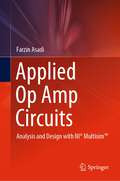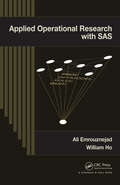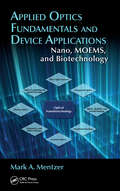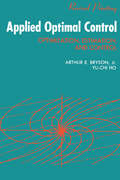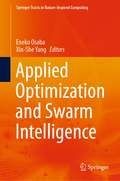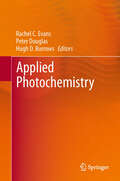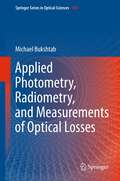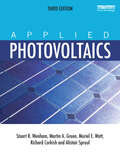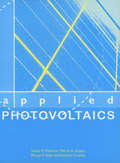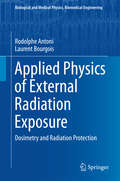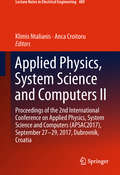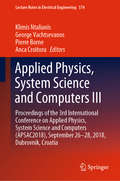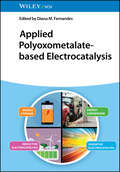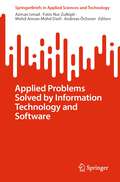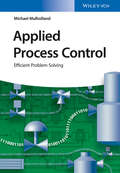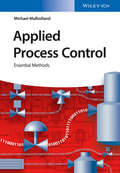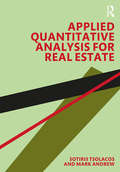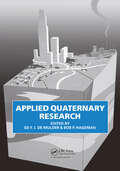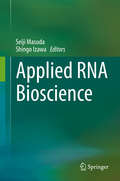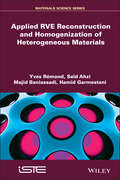- Table View
- List View
Applied Op Amp Circuits: Analysis and Design with NI® Multisim™
by Farzin AsadiThis book provides a compact but comprehensive treatment that guides the reader through the important applications of operational amplifiers. The author uses his extensive classroom experience to guide readers toward a deeper understanding of key concepts of operational amplifier circuits. The NI® Multisim™ is used throughout the book to analyze and design the circuits. The book is designed to serve as a textbook for courses offered to undergraduate and postgraduate students enrolled in electrical and computer engineering. The prerequisite for this book is a first course in electric circuits.
Applied Operational Research with SAS
by Ali Emrouznejad William HoUsing a wide range of operational research (OR) optimization examples, Applied Operational Research with SAS demonstrates how the OR procedures in SAS work. The book is one of the first to extensively cover the application of SAS procedures to OR problems, such as single criterion optimization, project management decisions, printed circuit board as
Applied Optics Fundamentals and Device Applications: Nano, MOEMS, and Biotechnology
by Mark A. MentzerHow does the field of optical engineering impact biotechnology? Perhaps for the first time, Applied Optics Fundamentals and Device Applications: Nano, MOEMS, and Biotechnology answers that question directly by integrating coverage of the many disciplines and applications involved in optical engineering, and then examining their applications in nanobiotechnology. Written by a senior U.S. Army research scientist and pioneer in the field of optical engineering, this book addresses the exponential growth in materials, applications, and cross-functional relevance of the many convergent disciplines making optical engineering possible, including nanotechnology, MEMS, (MOEMS), and biotechnology. Integrates Coverage of MOEMS, Optics, and Nanobiotechnology—and Their Market Applications Providing an unprecedented interdisciplinary perspective of optics technology, this book describes everything from core principles and fundamental relationships, to emerging technologies and practical application of devices and systems—including fiber-optic sensors, integrated and electro-optics, and specialized military applications. The author places special emphasis on: Fiber sensor systems Electro-optics and acousto-optics Optical computing and signal processing Optical device performance Thin film magnetic memory MEMS, MOEMS, nano- and bionanotechnologies Optical diagnostics and imaging Integrated optics Design constraints for materials, manufacturing, and application space Bridging the technology gaps between interrelated fields, this reference is a powerful tool for students, engineers and scientists in the electrical, chemical, mechanical, biological, aerospace, materials, and optics fields. Its value also extends to applied physicists and professionals interested in the relationships between emerging technologies and cross-disciplinary opportunities. Author Mark A. Mentzer is a pioneer in the field of optical engineering. He is a senior research scientist at the U.S. Army Research Laboratory in Maryland. Much of his current work involves extending the fields of optical engineering and solid state physics into the realm of biochemistry and molecular biology, as well as structured research in biophotonics.
Applied Optimal Control: Optimization, Estimation and Control
by A. E. BrysonThis best-selling text focuses on the analysis and design of complicated dynamics systems. CHOICE called it ""a high-level, concise book that could well be used as a reference by engineers, applied mathematicians, and undergraduates. The format is good, the presentation clear, the diagrams instructive, the examples and problems helpful...References and a multiple-choice examination are included.
Applied Optimization Methods for Wireless Networks
by Y. Thomas Hou Yi Shi Hanif D. SheraliWritten in a unique style, this book is a valuable resource for faculty, graduate students, and researchers in the communications and networking area whose work interfaces with optimization. It teaches you how various optimization methods can be applied to solve complex problems in wireless networks. Each chapter reviews a specific optimization method and then demonstrates how to apply the theory in practice through a detailed case study taken from state-of-the-art research. You will learn various tips and step-by-step instructions for developing optimization models, reformulations, and transformations, particularly in the context of cross-layer optimization problems in wireless networks involving flow routing (network layer), scheduling (link layer), and power control (physical layer). Throughout, a combination of techniques from both operations research and computer science disciplines provides a holistic treatment of optimization methods and their applications. Each chapter includes homework exercises, with PowerPoint slides and a solutions manual for instructors available online.
Applied Optimization and Swarm Intelligence (Springer Tracts in Nature-Inspired Computing)
by Xin-She Yang Eneko OsabaThis book gravitates on the prominent theories and recent developments of swarm intelligence methods, and their application in both synthetic and real-world optimization problems. The special interest will be placed in those algorithmic variants where biological processes observed in nature have underpinned the core operators underlying their search mechanisms. In other words, the book centers its attention on swarm intelligence and nature-inspired methods for efficient optimization and problem solving. The content of this book unleashes a great opportunity for researchers, lecturers and practitioners interested in swarm intelligence, optimization problems and artificial intelligence.
Applied Optimization in the Petroleum Industry
by Hesham K. AlfaresThe book addresses optimization in the petroleum industry from a practical, large-scale-application-oriented point of view. The models and techniques presented help to optimize the limited resources in the industry in order to maximize economic benefits, ensure operational safety, and reduce environmental impact. The book discusses several important real-life applications of optimization in the petroleum industry, ranging from the scheduling of personnel time to the blending of gasoline. It covers a wide spectrum of relevant activities, including drilling, producing, maintenance, and distribution. The text begins with an introductory overview of the petroleum industry and then of optimization models and techniques. The main body of the book details a variety of applications of optimization models and techniques within the petroleum industry.Applied Optimization in the Petroleum Industry helps readers to find effective optimization-based solutions to their own practical problems in a large and important industrial sector, still the main source of the world’s energy and the source of raw materials for a wide variety of industrial and consumer products.
Applied Photochemistry
by Peter Douglas Hugh D. Burrow Rachel C. EvansApplied Photochemistry encompasses the major applications of the chemical effects resulting from light absorption by atoms and molecules in chemistry, physics, medicine and engineering, and contains contributions from specialists in these key areas. Particular emphasis is placed both on how photochemistry contributes to these disciplines and on what the current developments are.The book starts with a general description of the interaction between light and matter, which provides the general background to photochemistry for non-specialists. The following chapters develop the general synthetic and mechanistic aspects of photochemistry as applied to both organic and inorganic materials, together with types of materials which are useful as light absorbers, emitters, sensitisers, etc. for a wide variety of applications. A detailed discussion is presented on the photochemical processes occurring in the Earth's atmosphere, including discussion of important current aspects such as ozone depletion. Two important distinct, but interconnected, applications of photochemistry are in photocatalytic treatment of wastes and in solar energy conversion. Semiconductor photochemistry plays an important role in these and is discussed with reference to both of these areas. Free radicals and reactive oxygen species are of major importance in many chemical, biological and medical applications of photochemistry, and are discussed in depth. The following chapters discuss the relevance of using light in medicine, both with various types of phototherapy and in medical diagnostics. The development of optical sensors and probes is closely related to diagnostics, but is also relevant to many other applications, and is discussed separately. Important aspects of applied photochemistry in electronics and imaging, through processes such as photolithography, are discussed and it is shown how this is allowing the increasing miniaturisation of semiconductor devices for a wide variety of electronics applications and the development of nanometer scale devices. The final two chapters provide the basic ideas necessary to set up a photochemical laboratory and to characterise excited states. This book is aimed at those in science, engineering and medicine who are interested in applying photochemistry in a broad spectrum of areas. Each chapter has the basic theories and methods for its particular applications and directs the reader to the current, important literature in the field, making Applied Photochemistry suitable for both the novice and the experienced photochemist.
Applied Photometry, Radiometry, and Measurements of Optical Losses (Springer Series in Optical Sciences #163)
by Michael BukshtabApplied Photometry, Radiometry, and Measurements of Optical Losses reviews and analyzes physical concepts of radiation transfer, providing quantitative foundation for the means of measurements of optical losses, which affect propagation and distribution of light waves in various media and in diverse optical systems and components. The comprehensive analysis of advanced methodologies for low-loss detection is outlined in comparison with the classic photometric and radiometric observations, having a broad range of techniques examined and summarized: from interferometric and calorimetric, resonator and polarization, phase-shift and ring-down decay, wavelength and frequency modulation to pulse separation and resonant, acousto-optic and emissive - subsequently compared to direct and balancing methods for studying free-space and polarization optics, fibers and waveguides. The material is focused on applying optical methods and procedures for evaluation of transparent, reflecting, scattering, absorbing, and aggregated objects, and for determination of power and energy parameters of radiation and color properties of light.
Applied Photovoltaics
by Martin A. Green Stuart R. Wenham Muriel E. Watt Richard Corkish Alistair SproulThe new edition of this thoroughly considered textbook provides a reliable, accessible and comprehensive guide for students of photovoltaic applications and renewable energy engineering. Written by a group of award-winning authors it is brimming with information and is carefully designed to meet the needs of its readers. Along with exercises and references at the end of each chapter, it features a set of detailed technical appendices that provide essential equations, data sources and standards. The new edition has been fully updated with the latest information on photovoltaic cells, modules, applications and policy. Starting from basics with 'The Characteristics of Sunlight' the reader is guided step-by-step through semiconductors and p-n junctions; the behaviour of solar cells; cell properties and design; and PV cell interconnection and module fabrication. The book covers stand-alone photovoltaic systems; specific purpose photovoltaic systems; remote area power supply systems; grid-connected photovoltaic systems and water pumping. Applied Photovoltaics is highly illustrated and very accessible, providing the reader with all the information needed to start working with photovoltaics.
Applied Photovoltaics
by Richard Corkish Martin A Green Muriel E Watt Stuart R WenhamA reliable, accessible and comprehensive guide for students of photovoltaic applications and renewable energy engineering. This thoroughly considered textbook from a group of leading influential and award-winning authors is brimming with information and is carefully designed to meet the needs of its readers. Along with exercises and references at the end of each chapter, the book features a set of detailed technical appendices that provide essential equations, data sources and standards. Starting from basics with 'The Characteristics of Sunlight' the reader is guided step-by-step through semiconductors and p-n junctions; the behaviour of solar cells; cell properties ad design; and PV cell interconnection and module fabrication. The book covers stand-alone photovoltaic systems; specific purpose photovoltaic systems; remote are power supply systems; and grid-connected photovoltaic systems. There is also a section on photovoltaic water pumping system components and design. Applied Photovolatics is well illustrated and readable with an abundance of diagrams and illustrations, and will provide the reader with all the information needed to start working with photovoltaics.
Applied Physics of External Radiation Exposure: Dosimetry and Radiation Protection (Biological and Medical Physics, Biomedical Engineering)
by Rodolphe Antoni Laurent BourgoisThis book describes the interaction of living matter with photons, neutrons, charged particles, electrons and ions. The authors are specialists in the field of radiation protection. The book synthesizes many years of experiments with external radiation exposure in the fields of dosimetry and radiation shielding in medical, industrial and research fields. It presents the basic physical concepts including dosimetry and offers a number of tools to be used by students, engineers and technicians to assess the radiological risk and the means to avoid them by calculating the appropriate shields. The theory of radiation interaction in matter is presented together with empirical formulas and abacus. Numerous numerical applications are treated to illustrate the different topics. The state of the art in radiation protection and dosimetry is presented in detail, especially in the field of simulation codes for external exposure to radiation, medical projects and advanced research. Moreover, important data spread in different up to date references are presented in this book. The book deals also with accelerators, X-rays facilities, sealed sources, dosimetry, Monte Carlo simulation and radiation regulation. Each chapter is split in two parts depending on the level of details the readers want to focus on. The first part, accessible to a large public, provides a lot of simple examples to help understanding the physics concepts under radiation external exposure. The second part, called "Additional Information" is not mandatory; it aims on explaining topics more deeply, often using mathematical formulations. The book treats fundamental radiometric and dosimetric quantities to describe the interaction in materials under the aspects of absorbed dose processes in tissues. Definitions and applications on limited and operational radiation protection quantities are given. An important aspect are practical engineering tools in industrial, medical and research domains. Source characterization and shielding design are addressed. Also more "exotic" topics, such as ultra intense laser and new generation accelerators, are treated. The state of the art is presented to help the reader to work with the book in a self-consistent way. The basic knowledge necessary to apply Monte Carlo methods in the field of radiation protection and dosimetry for external radiation exposure is provided. Coverage of topics such as variance reduction, pseudo-random number generation and statistic estimators make the book useful even to experienced Monte Carlo practitioners. Solved problems help the reader to understand the Monte Carlo process. The book is meant to be used by researchers, engineers and medical physicist. It is also valuable to technicians and students.
Applied Physics, System Science and Computers II: Proceedings of the 2nd International Conference on Applied Physics, System Science and Computers (APSAC2017), September 27-29, 2017, Dubrovnik, Croatia (Lecture Notes in Electrical Engineering #489)
by Klimis Ntalianis Anca CroitoruThis book reports on advanced theories and methods in three related fields of research: applied physics, system science and computers. It is organized in three parts, the first of which covers applied physics topics, including lasers and accelerators; condensed matter, soft matter and materials science; nanoscience and quantum engineering; atomic, molecular, optical and plasma physics; as well as nuclear and high-energy particle physics. It also addresses astrophysics, gravitation, earth and environmental science, as well as medical and biological physics. The second and third parts focus on advances in computers and system science, respectively, and report on automatic circuit control, power systems, computer communication, fluid mechanics, simulation and modeling, software engineering, data structures and applications of artificial intelligence among other areas. Offering a collection of contributions presented at the 2nd International Conference on Applied Physics, System Science and Computers (APSAC), held in Dubrovnik, Croatia on September 27–29, 2017, the book bridges the gap between applied physics and electrical engineering. It not only to presents new methods, but also promotes collaborations between different communities working on related topics at the interface between physics and engineering, with a special focus on communication, data modeling and visualization, quantum information, applied mechanics as well as bio and geophysics.
Applied Physics, System Science and Computers III: Proceedings of the 3rd International Conference on Applied Physics, System Science and Computers (APSAC2018), September 26-28, 2018, Dubrovnik, Croatia (Lecture Notes in Electrical Engineering #574)
by Pierre Borne Klimis Ntalianis Anca Croitoru George VachtsevanosThis book reports on advanced theories and methods in three related fields of research: applied physics, system science and computers. The first part covers applied physics topics, such as lasers and accelerators; fluid dynamics, optics and spectroscopy, among others. It also addresses astrophysics, security, and medical and biological physics. The second part focuses on advances in computers, such as those in the area of social networks, games, internet of things, deep learning models and more. The third part is especially related to systems science, covering swarm intelligence, smart cities, complexity and more. Advances in and application of computer communication, artificial intelligence, data analysis, simulation and modeling are also addressed. The book offers a collection of contributions presented at the 3nd International Conference on Applied Physics, System Science and Computers (APSAC), held in Dubrovnik, Croatia on September 26–28, 2018. Besides presenting new methods, it is also intended to promote collaborations between different communities working on related topics at the interface between physics, computer science and engineering.
Applied Polymer Rheology
by Marianna KontopoulouExplore polymer rheology from an industrial standpoint Presenting state-of-the-art polymer rheology as observed by well-recognized authors, Applied Polymer Rheology: Polymeric Fluids with Industrial Applications is designed to help readers understand the relationship between molecular structure and the flow behavior of polymers. In particular, it focuses on polymeric systems that elicit special attention from industry. Providing a comprehensive overview of the rheological characteristics of polymeric fluids, the book bridges the gap between theory and practice/application, enabling readers to see the connection between molecular structure and the behavior of the polymers studied. Beginning with a discussion of the properties, processability, and processing aids of specific polymers, later chapters examine filled polymers and composites, and the theoretical framework upon which their analysis is based. Various systems containing microstructure are presented subsequently, with the final chapter introducing paste extrusion of polytetrafluoroethylene paste. An invaluable reference guide that covers the literature and vast array of technical approaches to polymer rheology, Applied Polymer Rheology's coverage of polymeric fluids of interest to industry make it an essential resource for plastics, polymer, and chemical engineers, materials scientists, polymer chemists, and polymer physicists to use when interpreting findings and planning experiments.
Applied Polymer Science
by Minna Hakkarainen Ulf W. Gedde Mikael S. Hedenqvist Fritjof Nilsson Oisik DasThis companion volume to “Fundamental Polymer Science” (Gedde and Hedenqvist, 2019) offers detailed insights from leading practitioners into experimental methods, simulation and modelling, mechanical and transport properties, processing, and sustainability issues. Separate chapters are devoted to thermal analysis, microscopy, spectroscopy, scattering methods, and chromatography. Special problems and pitfalls related to the study of polymers are addressed. Careful editing for consistency and cross-referencing among the chapters, high-quality graphics, worked-out examples, and numerous references to the specialist literature make “Applied Polymer Science” an essential reference for advanced students and practicing chemists, physicists, and engineers who want to solve problems with the use of polymeric materials.
Applied Polyoxometalate-Based Electrocatalysis
by Diana M. FernandesWell-researched reference on stable alternative electrocatalysts and electrode materials with the potential to transform chemistry and processes in sensor- and energy-related technologies Applied Polyoxometalate-based Electrocatalysis delivers an overview of the variety of efficient applications of free POM and POM-based (nano)composites as exciting materials in the field of electrocatalysis. With a variety of sizes, shapes, composition, and physical and chemical properties, these composites have important properties, such as the ability to undergo reversible multivalence reductions/oxidations, leading to the formation of mixed-valence species, which brings about favorable electrocatalytic properties with regard to several electrochemical processes. Edited by a highly qualified independent researcher internationally recognized for her contributions to materials for electrochemical energy-related reactions, Applied Polyoxometalate-based Electrocatalysis includes information on: General methodologies used in the preparation of free POMs and POM-based nanocomposites and different strategies employed in electrode modification Role of POM-modified electrodes in oxidative and reductive electrocatalysis, including the detection/sensing of several (bio)molecules of interest and carbon dioxide electroreduction Application of POM-based (nano)composites, including the oxygen reduction reaction relevant to fuel cells, the oxygen and hydrogen evolution reactions, and batteries and supercapacitors Applied Polyoxometalate-based Electrocatalysis is an essential reference on the subject for chemists, material scientists, chemical engineers, and institutions involved in work related to free POM and POM-based (nano)composites.
Applied Problems Solved by Information Technology and Software (SpringerBriefs in Applied Sciences and Technology)
by Andreas Öchsner Azman Ismail Mohd Amran Mohd Daril Fatin Nur ZulkipliThis book explores a dynamic landscape where cutting-edge technologies are revolutionizing various domains. This captivating book delves into the advancements in security, communication, and environmental management, highlighting their profound impact on society. The developments bridge the gap between human needs and technological innovation. Readers will uncover the fascinating world of IoT-driven devices that seamlessly integrate into our lives, ensuring enhanced safety and communication efficiency. This book is a must-read for technology enthusiasts, researchers, and anyone curious about the transformative power of technology in shaping our present and future.
Applied Process Control: Efficient Problem Solving
by Michael MulhollandBridging theory and practice, this book contains over 200 practical exercises and their solutions, to develop the problem-solving abilities of process engineers. The problems were developed by the author during his many years of teaching at university and are kept brief, taken from the fields of instrumentation, modelling, plant control, control strategy design and stability of control. The algorithm flows and codes, which are mostly based on MATLAB?, are given in many cases and allow for easy translation into applications. Since the text is structured according to "Applied Process Control: Essential Methods", all of the necessary background information on the underlying methods can be easily and quickly found in this accompanying book.
Applied Process Control: Essential Methods
by Michael MulhollandThe basic working knowledge for the practicing control engineer in industry, offered here as a handy deluxe edition comprising two volumes each devoted to methods and practical problems. Focusing on their practical implementation, the methods volume provides readers with rapid access to process modelling and control, while including the theoretical background necessary. Throughout, the essential knowledge is built up from chapter to chapter, such that by the end readers have the means to design simple controllers on the basis of their own models, and to use more detailed models to test them. With its clarity and simplicity of presentation, and illustrated by more than 200 diagrams, the volume supports self-study and teaches readers how to apply the appropriate method for the application required and to handle problems in process control. Bridging theory and practice, the second volume contains over 200 practical exercises and their solutions to train problem-solving abilities in process control. The problems were developed by the author during his many years of teaching at university and are kept brief, taken from the fields of instrumentation, modeling, plant control, control strategy design and stability of control. The algorithm flows and codes, which are mostly based on MATLAB?, are given in many cases and allow for easy translation into applications. With a clarity and simplicity of presentation, the two volumes are similarly structured for easy orientation.
Applied Quantitative Analysis for Real Estate
by Sotiris Tsolacos Mark AndrewTo fully function in today’s global real estate industry, students and professionals increasingly need to understand how to implement essential and cutting-edge quantitative techniques. This book presents an easy-to-read guide to applying quantitative analysis in real estate aimed at non-cognate undergraduate and masters students, and meets the requirements of modern professional practice. Through case studies and examples illustrating applications using data sourced from dedicated real estate information providers and major firms in the industry, the book provides an introduction to the foundations underlying statistical data analysis, common data manipulations and understanding descriptive statistics, before gradually building up to more advanced quantitative analysis, modelling and forecasting of real estate markets. Our examples and case studies within the chapters have been specifically compiled for this book and explicitly designed to help the reader acquire a better understanding of the quantitative methods addressed in each chapter. Our objective is to equip readers with the skills needed to confidently carry out their own quantitative analysis and be able to interpret empirical results from academic work and practitioner studies in the field of real estate and in other asset classes. Both undergraduate and masters level students, as well as real estate analysts in the professions, will find this book to be essential reading.
Applied Quaternary Research
by ED F.J.DE MULDER Bob P. HagemanProceedings of a symposium at the 1987 INQUA Congress, Ottawa, Aug. 1987. Contributions present the application of quaternary studies to land use planning and development. No index. Annotation copyright Book News, Inc. Portland, Or.
Applied RNA Bioscience
by Seiji Masuda Shingo IzawaThe focus of this book is to introduce up-to-date information on applications and practical use of RNA for agriculture, biotechnology and medicine.<P><P> It provides unique ideas, tools, and methods in detail from a variety of scientific and technical disciplines. RNA science has progressed enormously in recent decades, and vast amounts of information on RNA functions and their regulatory mechanisms are becoming available. Such a progress opened the door to an age of practical application of RNA in many fields including agriculture, plant science, medical science, brewing and fermentation technology, and material production. <P>This book inspires its readership and contributes to not only expansion in application of RNA but also to basic research.
Applied RVE Reconstruction and Homogenization of Heterogeneous Materials
by Majid Baniassadi Hamid Garmestani Yves Rémond Said AhziStatistical correlation functions are a well-known class of statistical descriptors that can be used to describe the morphology and the microstructure-properties relationship. A comprehensive study has been performed for the use of these correlation functions for the reconstruction and homogenization in nano-composite materials. Correlation functions are measured from different techniques such as microscopy (SEM or TEM), small angle X-ray scattering (SAXS) and can be generated through Monte Carlo simulations. In this book, different experimental techniques such as SAXS and image processing are presented, which are used to measure two-point correlation function correlation for multi-phase polymer composites. Higher order correlation functions must be calculated or measured to increase the precision of the statistical continuum approach. To achieve this aim, a new approximation methodology is utilized to obtain N-point correlation functions for multiphase heterogeneous materials. The two-point functions measured by different techniques have been exploited to reconstruct the microstructure of heterogeneous media. Statistical continuum theory is used to predict the effective thermal conductivity and elastic modulus of polymer composites. N-point probability functions as statistical descriptors of inclusions have been exploited to solve strong contrast homogenization for effective thermal conductivity and elastic modulus properties of heterogeneous materials. Finally, reconstructed microstructure is used to calculate effective properties and damage modeling of heterogeneous materials.
